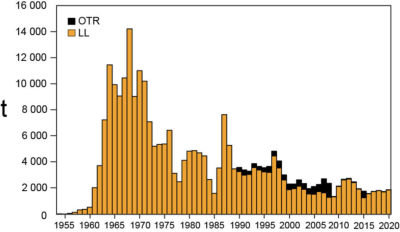Habitat Bio
Depth Zone: Abyssal ( >1000m). Horizontal Dist: Oceanic. Vertical Dist: Pelagic.
Geo Dist
Geo Dist: Highly migratory
Aq Res Struct
Biological Stock: Yes
Striped marlin (
Kajikia audax) occur throughout the Pacific Ocean between about 45°N and 45°S. The assessment on which this report is based is for the stock of striped marlin in the eastern Pacific Ocean (EPO) north of 10°S, east of about 145°W north of the equator, and east of about 165°W south of the equator. Although not included in the assessment model, there may be limited exchange of fish between this stock and stocks in adjacent regions.
Significant effort has been devoted to understanding the stock structure of striped marlin in the Pacific Ocean, which is moderately well known. It is clear that there are a number of stocks. Information on movement from research studies deploying conventional dart tags is limited, although over 40,000 striped marlin have been tagged by various volunteer recreational fisher tagging programs. Although reported recapture rates are below 1%, recapture data show that striped marlin are capable of moving long distances (5,000–6,000 km), however, most recaptures have occurred reasonably close to the release location. In the EPO specifically, fish tagged off the tip of Baja California were generally recaptured near where they were tagged, but some were recaptured around the Revillagigedo Islands, a few around Hawaii, and one near Norfolk Island, off Australia. Tagging studies in the Pacific, using pop-off satellite tags, indicated that there is essentially no mixing among tagging areas, and that striped marlin maintain site fidelity. Analyses of fisheries and genetic data indicate that the northern EPO supports a single stock, though there may be a seasonal low-level presence of juveniles from a more westerly Hawaii/Japan stock.
The last full assessment of striped marlin was conducted in 2008, using Stock Synthesis, and later updated with data through October 2010.
Exploit
Historically, the majority of the catch in the EPO was taken by longline fisheries, which began expanding into the EPO in the mid-1950s and extended throughout the region by the late 1960s. Except for a few years in the late 1960s to early 1970s in the northern EPO, these fisheries did not target billfish. More recently, catches by recreational fisheries have become important, although most fish caught are released (Figure I-1).
 |
Figure I-1: Total reported catches of striped marlin in the North EPO by longline (LL) and other (OTR) fisheries (primarily recreational, 1954–2020. Due to unreported catches by recreational fisheries, estimates for 2009–2020 are minimums.  |
However, the survival rate of released fish is little understood.
Fishing by artisanal longline vessels targeting tuna and other species off Central America, for which data availability is limited, appears to have increased, over the past decade at least. The shifting patterns of areas fished and targeting practices increase the difficulties encountered when using fisheries data in analyses of stock status and trends. These difficulties are exacerbated when analyzing species which are not principal targets of the fishery, and further complicated when the total catch of the species by all fisheries is not known.
The fishing effort by large longline vessels in the North EPO has increased by about 20% since 2010, but the catch of striped marlin has remained largely unchanged. In 2022, the ISC completed a full assessment of the North Pacific stock of striped marlin for the period 1977–2020. This assessment showed a decline in the estimated female spawning stock biomass from 7,849 mt in 1977 to 2,546 mt in 1999 and has averaged around 3,400 mt thereafter. There was a marked reduction in fishing mortality from a peak of 0.76 yr
-1 in 1998 to 0.34 yr
-1 in 2020. The stock was deemed neither to be overfished nor subject to overfishing relative to
F20%SSB and SSB
20% reference points.
The recreational fishery has increased its contribution to the total annual reported catches of striped marlin in the EPO, particularly in the North EPO, from around 10% in 1990 to 64% and 84% in 2007 and 2008, respectively. However, a paucity of reported data since 2009 probably means that the catches of striped marlin in the EPO have been significantly underestimated since this time. Also, it appears that catches of billfishes, including striped marlin, by the artisanal longline fishery operating off Central America are not reported, at least not to the IATTC, or are incomplete. Therefore, the total catch of striped marlin in the EPO, and thus the total impact of fishing on the stock since about 2009, are not known.
See also fishery fact sheet:
EPO Tunas and billfishes fishery Bio Assess
Results
Efforts continue to obtain reliable catch data from all fisheries. Until the data are available and updated, and a review of the status of striped marlin in the EPO is completed, it is recommended that, as a precautionary measure, fishing effort by fisheries that take the majority of the striped marlin catch in the EPO not be increased.
Key results of the assessment were that- The stock is not overfished.
- Overfishing is not occurring.
- The spawning stock biomass was above the level that would support MSY.
- More recently, average annual catches during 2016–2020 (1,735 t) were at about half the estimated MSY level in 2010. If fishing effort and catches continue at the 2010 level (2,129 t), it is expected that the biomass of the stock will continue to increase over the near term.





